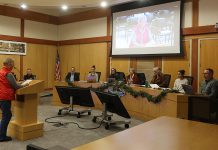At the Jan. 20 board meeting of the West Sonoma County Union High School District (WSCUHSD), the superintendent and chief business official reported on its shifting financial outlook and measures, including possible breakthroughs in Gov. Gavin Newsom’s state budget proposal to be worked over in the state legislature in the coming months.
Superintendent Toni Beal reported that the district received its letter from the Sonoma County Office of Education (SCOE) concurring with the district’s first interim report that the district’s status is qualified, or potentially unable to afford its financial obligations in the current or two subsequent fiscal years.
The district must now come up with a fiscal recovery plan to outline how it will maintain minimum reserves and grapple with the deficit spending, so the district will get the superintendent’s budget committee back together again, she said.
“The hope is that we can get many of the people that were on the superintendent’s committee in the past years to continue so we don’t have to start from scratch in explaining our budget, but certainly we will welcome new members to that and there will be slots for community members to be included in that committee,” Beal said.
The fiscal recovery plan and the second interim report must be delivered to SCOE by March 15 at the latest, though they will reach the board at the March 10 meeting, Chief Business Official Jeff Ogston said in a Jan. 28 email with Sonoma West Times & News.
Adding to the budget, the district may need to spend close to $70,000 on a demographic study and legal fees due to a process set in motion by a letter from community members about possible noncompliance with the California Voting Rights Act (CVRA) of 2001 in the district’s trustee election method, Beal said in a Jan. 22 interview.
She said it would not affect the second interim budget report, but the potential cost would require more reductions to the 2022-23 budget.
“I think the CVRA letter falls in the same pot as anything else that would increase expenses,” Ogston said over email. “In this case here, I think the easiest way to think about it is that the cost associated with it will increase the reductions needed in 2022-23 by the same amount.”
What Newsom’s state budget proposal could do for WSCUHSD
When Ogston presented on how the newly proposed state budget could affect the district, he said the state’s finances were in much better shape than expected.
“Unfortunately, we can’t just plan in a vacuum of one year of good news,” he said.
According to Ogston, two major school funding proposals that could make a difference for the district are the governor’s suggested $7.3 billion toward payments on most deferrals in the 2021-2022 fiscal year and $2.2 billion to bring about a 3.84% combined, compounded cost of living adjustment (COLA) for the Local Control Funding Formula (LCFF), “and 1.5% COLA for other programs.”
Previously, Ogston said state deferrals of school funding add to the financial challenges facing the district, as reported by Sonoma West Times & News in November 2020.
“The deferrals for this year, for 2021, are still in play,” he said at the meeting.
He said while deferrals set for February through June of 2021 wouldn’t budge, the proposal would basically clear the ones set for February through May of 2022, leaving primarily the June deferrals in place for the next fiscal year.
“What that means for us as far as the second interim is that it takes out I think one of the things that could cause us not to meet our financial obligations,” Ogston said.
The chief business official calculated four budget scenarios depending on Newsom’s proposal and “a more conservative projection” from education consulting company School Services of California, Inc. According to Ogston’s presentation, the district may need to identify budget reductions for 2022-23 as low as $600,000 and as high as about $1.7 million.
He had projected that there would be no COLA funding increases planned for the next two years at the time of first interim, and so predicted the district would run into $1.45 million in deficit-spending in the 2021-22 year and $2 million in the 2022-23 year, “and we were looking at an absolute minimum of $1.8 million in reductions from the following year,” he said.
“This is where we’re currently at. So, this is where the big conversations are coming from,” he said.
Doing the math with the governor’s proposed cost of living adjustments, Ogston projected a lower $1 million deficit-spending in 2021-22 and $1.2 million in 2022-23, requiring at least $600,000 in budget cuts for the 2022-23 fiscal year.
With School Services’ lower COLA projections in future years, Ogston said the district could still spend $1 million it doesn’t have in 2021-22 and $1.4 million in the 2022-23 fiscal year, calling for a minimum of $800,000 in reductions that year.
“So, I’ve talked with SCOE as far as the second interim goes and what assumptions we can use, and it’s my understanding as of right now that I will be able to use one of these two assumptions,” he said, adding he will keep calculating both scenarios.
The district also faces ongoing declining enrollment that saps the funds, so Ogston ran two more scenarios accounting for a 5% drop in enrollment more than what the district is already bracing for, or a loss of about 90 students. If around 90 students left the district, he said the governor’s proposal would leave the district with $1.3 million in deficit-spending for the 2021-22 fiscal year and $1.6 million in deficit-spending in 2022-23, for at least $1.5 million in required cuts that last year.
Finally, a 5% dip in enrollment met with School Service’s lower anticipated cost of living adjustments would lead to a projected $1.3 million in deficit-spending in 2021-22 and $1.9 million in 2022-23, according to Ogston. The district would have to come up with $1.7 million in cuts for the 2022-23 budget, he said.
“We still remain with a significant structural deficit that I feel should be remedied for the long-term health of the district,” Ogston said.
Committees starting up
The superintendent said at the Jan. 20 meeting that the district strives to launch more district committees at the start of February, including one for reviewing recent and incoming curriculum and another composed of teachers and classified staff to recommend a new bell schedule.
Beal said the district is also initiating a unity committee. “Their focus would be to start bringing us together as a district now. And like I said, whether we consolidate or not, there are many activities we can do to bring the district together and have us all working towards one goal for students,” she said.
Furthermore, Beal said the district will be starting up a Local Control and Accountability Plan (LCAP) committee, since the district is due to file a plan for public hearing and approval in June, which “does control our supplemental grant funds we get from the state.”









